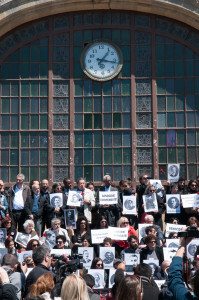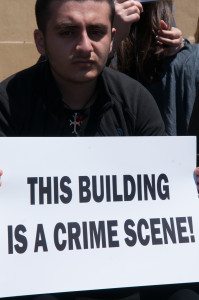Special for the Armenian Weekly
I was awakened unexpectedly at 4 a.m. on April 24, 2015.
There was no knock at the door. No noise on the street. No alarm clock. Just a sudden awakening and an early start to a long day.

A scene from the Armenian Genocide commemoration held at the Haydarpasha train station (Photo: Matthew Karanian)
The day was still two hours shy of sunrise, but I was unable to rest. Instead, I stared out the window of my hotel room, and I squinted at the distant lights of Taksim Square in central Istanbul.
One hundred years ago, hundreds of others were awakened at this same hour in this same city. For most of them, it would be the start of a life-ending journey. For me, it was the start of another day trying to make sense of a senseless event.
I was in Istanbul on April 24 because I wanted to be in the city where, 100 years earlier, the warrant for the arrest of the Armenian nation was first executed. I wanted to commemorate our national tragedy in the place where the tragedy had begun.
On April 24, 1915, hundreds of Armenian intellectuals, activists, and national leaders had been rousted from their sleep without explanation, setting in motion a national holocaust and a century-long national trauma.
Some of these leaders had lived in the Taksim Square area of central Istanbul. Gomidas, the cultural and artistic leader of the Armenian nation, was one of them. He lived in an apartment just down the street from my hotel.
And so I found myself, on April 24, 2015, at the Ground Zero of the Armenian Genocide staring up at a window that I imagined might have been the bedroom window of Gomidas himself.
The Armenian community, and friends of the Armenians, protested peacefully in Istanbul on April 24 this year. There were candle-light vigils and public gatherings of prayer. There was a memorial concert. And there was a short pilgrimage, a march, from Taksim Square to the former home of Gomidas.

A man holds a sign reading, ‘This building is a crime scene,’ at the Haydarpasha train station (Photo: Matthew Karanian)
I walked with a group of hundreds to the former Gomidas home. The crowd was too large for the sidewalk, but not too large to go unnoticed. We marched. We held placards at the home, which is today located above a modern drug store. We created a traffic jam because we unavoidably blocked one lane of traffic on the busy street.
But when the vigil here had ended, and after we had walked back to our hotels, the traffic again flowed freely, and Istanbul went on with its business. I imagined that we had today been unnoticed. That we had been unimportant to the business, the politics, and the cultural life of Istanbul.
One hundred years ago, after our leaders had been arrested, they were taken by train to a central station just outside the city. Here, at this train station, called Haydarpasha, the gravity of the situation first became apparent to many of the arrestees.
At the train station, our leaders realized that they weren’t alone.
They looked about and discovered their Armenian neighbors were here, too. They each realized that their arrest hadn’t been a single, solitary mistake that could be corrected. They realized that the entire leadership of the Armenian community of Istanbul had been targeted, arrested, and put on a train east.
And so, on the afternoon of April 24, I arrived at this same train station. I suppose I may have arrived at the same hour, or at least on the same date, as my ancestors had, 100 years earlier.
Hundreds of other Armenians, and friends of Armenians, made the same journey on April 24, 2015. We displayed placards that showed the faces of some of the arrestees. We held a banner commemorating the genocide. Some signs declared that the train station was a crime scene.
Customers at a nearby café were curious. But not too curious. They didn’t leave their seats. Our vigil was briefly disturbed by the noise of a nearby construction worker’s jack hammer until one of the protesters admonished the worker to stop working, at least for a few minutes. He obliged.
And then we left. The café resumed selling Turkish coffee.
The construction worker returned to work.
And the two dozen or so tactical police who had been standing by just around the corner, out of sight, went on to their next job.
One hundred years ago, the arrestees who we commemorated here had subsequently been transported for processing at a station just outside Ankara, which is east of Istanbul. And so on April 25, 2015, I traveled to this location as well. I was following the path of destruction.
On April 25, I found myself at the site of the prison where our arrestees had been taken following their arrests, a remote place outside Ankara, a place known as Ayash.
I looked for the prison. Instead I found the Turkish equivalent of a Seven-Eleven. The site had been cleansed of its history.
I was traveling with a small group. We unfurled a banner commemorating our national loss. Someone in our group spoke a few words in memoriam. And then we left.
There was no one to see our banner. No one to hear our words. But we observed our loss. And we remembered our past. Our origin.
And then the dust settled back down on Ayash—a forgotten footnote of a town, perhaps, for local historians. But a painful headline for the Armenian nation.
Matthew Karanian is a lawyer in Pasadena, Calif. He is the author of the newly published book, Historic Armenia After 100 Years, which details the cultural and historic Armenian landmarks of Ani, Kars, and the six provinces of Western Armenia. Details at www.HistoricArmeniaBook.com.
The post From Haydarpasha to Ayash on April 24 … 2015 appeared first on Armenian Weekly.